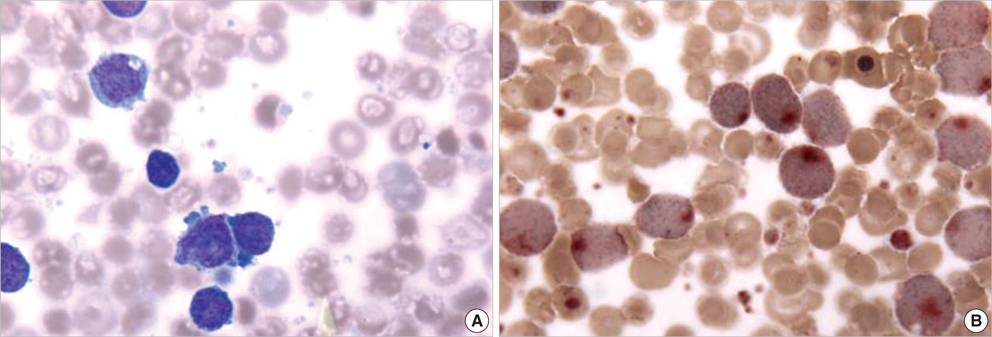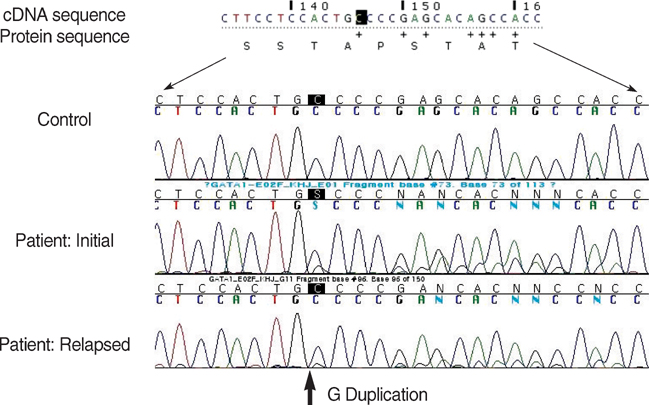J Korean Med Sci.
2008 Dec;23(6):1105-1108. 10.3346/jkms.2008.23.6.1105.
A Novel Mutation in the GATA1 Gene Associated with Acute Megakaryoblastic Leukemia in a Korean Down Syndrome Patient
- Affiliations
-
- 1Department of Laboratory Medicine, Gyeongsang National University Hospital, Jinju, Korea.
- 2Department of Pediatrics, Gyeongsang National University Hospital, Jinju, Korea. espark@gsnu.ac.kr
- 3Department of Laboratory Medicine, Samsung Medical Center, Sungkyunkwan University School of Medicine, Seoul, Korea.
- 4Department of Laboratory Medicine, University of Ulsan, College of Medicine and Asan Medical Center, Seoul, Korea.
- KMID: 1107540
- DOI: http://doi.org/10.3346/jkms.2008.23.6.1105
Abstract
- Although acquired mutations in the GATA1 gene have been reported for Down syndrome-related acute megakaryoblastic leukemia (DS-AMKL) in Caucasians, this is the first report of a Korean Down syndrome patient with AMKL carrying a novel mutation of the GATA1 gene. A 3-yr-old Korean girl with Down syndrome was admitted to our hospital complaining of pallor and fever. The findings of a peripheral blood smear and bone marrow study were compatible with the presence of AMKL. A chromosome study showed 48,XX,-7,+21c,+21,+r[3]/47,XX,+21c[17]. Following GATA1 gene mutation analysis, a novel mutation, c.145dupG (p.Ala49GlyfsX18), was identified in the N-terminal activation domain of the GATA1 gene. This mutation caused a premature termination at codon 67 and expression of an abnormal GATA-1 protein with a defective N-terminal activation domain, and the absence of full-length GATA-1 protein. This case demonstrates that a leukemogenic mechanism for DS-AMKL is contributed by a unique collaboration between overexpressed genes from trisomy 21 and an acquired GATA1 mutation previously seen in Caucasians and now in a Korean patient.
MeSH Terms
Figure
Reference
-
1. Zipursky A, Poon A, Doyle J. Leukemia in Down syndrome: a review. Pediatr Hematol Oncol. 1992. 9:139–149.
Article2. Wechsler J, Greene M, McDevitt MA, Anastasi J, Karp JE, Le Beau MM, Crispino JD. Acquired mutations in GATA1 in the megakaryoblastic leukemia of Down syndrome. Nat Genet. 2002. 32:148–152.
Article3. Magalhaes IQ, Splendore A, Emerenciano M, Figueiredo A, Ferrari I, Pombo-de-Oliveira MS. GATA1 mutations in acute leukemia in children with Down syndrome. Cancer Genet Cytogenet. 2006. 166:112–116.4. Crispino JD. GATA1 mutations in Down syndrome: implications for biology and diagnosis of children with transient myeloproliferative disorder and acute megakaryoblastic leukemia. Pediatr Blood Cancer. 2005. 44:40–44.
Article5. Magalhaes IQ, Splendore A, Emerenciano M, Cordoba MS, Cordoba JC, Allemand PA, Ferrari I, Pombo-de-Oliveira MS. Transient neonatal myeloproliferative disorder without Down syndrome and detection of GATA1 mutation. J Pediatr Hematol Oncol. 2005. 27:50–52.6. Ahmed M, Sternberg A, Hall G, Thomas A, Smith O, O'Marcaigh A, Wynn R, Stevens R, Addison M, King D, Stewart B, Gibson B, Roberts I, Vyas P. Natural history of GATA1 mutations in Down syndrome. Blood. 2004. 103:2480–2489.
Article7. Greene ME, Mundschau G, Wechsler J, McDevitt M, Gamis A, Karp J, Gurbuxani S, Arceci R, Crispino JD. Mutations in GATA1 in both transient myeloproliferative disorder and acute megakaryoblastic leukemia of Down syndrome. Blood Cells Mol Dis. 2003. 31:351–356.
Article8. Rainis L, Bercovich D, Strehl S, Teigler-Schlegel A, Stark B, Trka J, Amariglio N, Biondi A, Muler I, Rechavi G, Kempski H, Haas OA, Izraeli S. Mutations in exon 2 of GATA1 are early events in megakaryocytic malignancies associated with trisomy 21. Blood. 2003. 102:981–986.
Article9. Hitzler JK, Cheung J, Li Y, Scherer SW, Zipursky A. GATA1 mutations in transient leukemia and acute megakaryoblastic leukemia of Down syndrome. Blood. 2003. 101:4301–4304.
Article10. Pine SR, Guo Q, Yin C, Jayabose S, Levendoglu-Tugal O, Ozkaynak MF, Sandoval C. GATA1 as a new target to detect minimal residual disease in both transient leukemia and megakaryoblastic leukemia of Down syndrome. Leuk Res. 2005. 29:1353–1356.
Article11. Sandoval C, Pine SR, Guo Q, Sastry S, Stewart J, Kronn D, Jayabose S. Tetrasomy 21 transient leukemia with a GATA1 mutation in a phenotypically normal trisomy 21 mosaic infant: case report and review of the literature. Pediatr Blood Cancer. 2005. 44:85–91.12. Izraeli S, Rainis L, Hertzberg L, Smooha G, Birger Y. Trisomy of chromosome 21 in leukemogenesis. Blood Cells Mol Dis. 2007. 39:156–159.
Article13. Xu G, Kanezaki R, Toki T, Watanabe S, Takahashi Y, Terui K, Kitabayashi I, Ito E. Physical association of the patient-specific GATA1 mutants with RUNX1 in acute megakaryoblastic leukemia accompanying Down syndrome. Leukemia. 2006. 20:1002–1008.
Article14. Elagib KE, Racke FK, Mogass M, Khetawat R, Delehanty LL, Goldfarb AN. RUNX1 and GATA-1 coexpression and cooperation in megakaryocytic differentiation. Blood. 2003. 101:4333–4341.
Article15. Rainis L, Toki T, Pimanda JE, Rosenthal E, Machol K, Strehl S, Gottgens B, Ito E, Izraeli S. The proto-oncogene ERG in megakaryoblastic leukemias. Cancer Res. 2005. 65:7596–7602.
Article16. Vyas P, Crispino JD. Molecular insights into Down syndrome-associated leukemia. Curr Opin Pediatr. 2007. 19:9–14.
Article17. Osato M, Yanagida M, Shigesada K, Ito Y. Point mutations of the RUNx1/AML1 gene in sporadic and familial myeloid leukemias. Int J Hematol. 2001. 74:245–251.
Article18. Preudhomme C, Warot-Loze D, Roumier C, Grardel-Duflos N, Garand R, Lai JL, Dastugue N, Macintyre E, Denis C, Bauters F, Kerckaert JP, Cosson A, Fenaux P. High incidence of biallelic point mutations in the Runt domain of the AML1/PEBP2 alpha B gene in Mo acute myeloid leukemia and in myeloid malignancies with acquired trisomy 21. Blood. 2000. 96:2862–2869.
- Full Text Links
- Actions
-
Cited
- CITED
-
- Close
- Share
- Similar articles
-
- GATA1-positive Acute Megakaryoblastic Leukemia in a 6.9-year-old Patient with Down Syndrome: What is the Prognosis?
- GATA1 Mutation in Transient Myeloproliferative Disorder of Down Syndrome
- A case of acute megakaryoblastic leukemia with Down syndrome
- A Case of Acute Megakaryoblastic Leukemia in infantwith down Syndrome
- A case of leukemia cutis in acute megakaryoblastic leukemia




